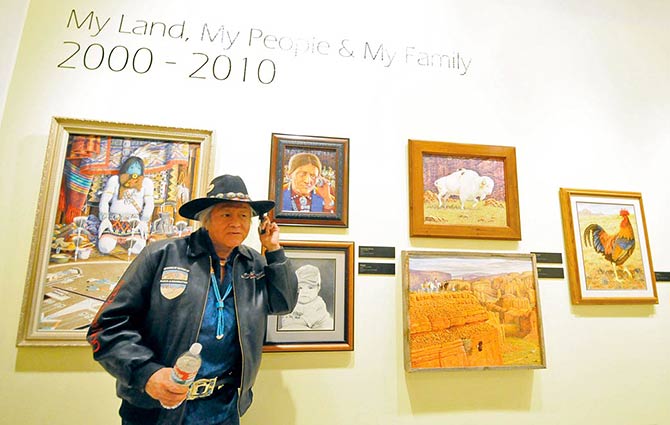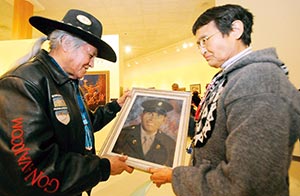A revolution in painting

(Special to the Times - Donovan Quintero)
Navajo artist Jim Abeita pretends to be on a call with his artwork April 15 during the opening of his exhibition at the Navajo Nation Museum. Abeita's work will be on display at the museum until April 14, 2012.
Navajo Nation Museum's Abeita show spans career of famous artist
By Noel Lyn Smith
Navajo Times
WINDOW ROCK, April 21, 2011

(Special to the Times - Donovan Quintero)
Navajo artist Jim Abeita, left, looks at a portrait he made in 1971 for Kate Martin of St. Michaels, Ariz., at the Navajo Nation Museum. Abeita painted a portrait of Martin's late father, World War II veteran Tom Cowboy.
"He's inside," a woman said to her friend as they moved along the sidewalk.
The person they were talking about is Navajo artist Jim Abeita.
"Master Artist: Jim Abeita" is the museum's newest exhibit and features approximately 70 paintings that span Abeita's prolific career from 1965 to now.
The exhibit opens with five paintings created from 1965 to 1969, including a rare watercolor of a creeping tiger titled "Bengal."
Many of the paintings from 1970 to 1979 were featured in the book "The American Indians of Abeita: His People." Among those on display are "Wasted Days," "Hataalii," "Faith and Hope," and "Grand Prize Belt."
"It's been the greatest life you could think of," Abeita said during the opening reception, which kicked off the yearlong exhibit.
Dressed in a forest green velvet shirt with a concho belt, turquoise jewelry and black hat, Abeita told the audience that art has always been a part of his life.
He said he got interested in oil painting from seeing Norman Rockwell's work on the cover of the Saturday Evening Post.
"I always enjoyed his art," Abeita said.
It was Abeita's night, as well as his 64th birthday, which was celebrated with cake at the exhibit opening.
Before the reception started, Abeita signed autographs and posed for pictures in the gallery.
Kate Martin, one of Abeita's cousins and one of the many family members in attendance, brought a portrait that Abeita painted of her father, Tom Cowboy, who enlisted in the Army during World War II.
The portrait depicts Cowboy in his uniform with a U.S. flag in the background. Abeita looked surprised when Martin showed him the portrait.
"I didn't forget about the painting but, man, it was a long time ago," Abeita said.
Martin recalled that Abeita wanted to paint Cowboy.
"He said, 'This is my grandfather and I'll do it for you.' It looks exactly like my father," she said.
Long time coming
LaVerne Abeita Watchman, one of Abeita's sisters, and Annie Charley, Abeita's aunt, reflected on the significance of the exhibit as they gazed at "Sandpainting Ceremony," an oil-on-mason-board from 1970.
"It's been a long time coming," Watchman said of the recognition her brother is receiving as a pivotal figure in modern Navajo art.
Abeita is the second oldest of 15 siblings, she said, and he played the role of big brother well, even making paper dolls for her.
Watchman remembers being one of Abeita's first models.
"In high school he would tell me to 'sit there and don't smile' then he would draw portraits of me," she said.
Another of Abeita's sisters, Lorena Charles, remembered him herding sheep and as the animals grazed, he passed the time drawing on the nearby sandstone.
"He was always busy," she said.
When the young Abeita ran out of watercolors he used charcoal from the stove to draw, she said. Later, when he and his wife Hannah moved to Chicago in 1967, Charles followed them after graduating from high school.
She was living with them when Hannah sold several pieces of Jim's art to a local gallery. The gallery had locations throughout the world and placed additional orders for his work, starting him on the road to what would become an extraordinary career.
Earlier this month, Charles was at the Museum of Church History and Art in Salt Lake City and saw one of her brother's paintings on display. Abeita's Mormon foster parents donated it, she explained.
"It is on display and it is so beautiful," she said.
As the evening in Window Rock continued, more and more people entered to view the collection. Putting together the Abeita show was no easy task, said museum curator Clarenda Begay. All the paintings are on loan, either from art collectors or from Abeita's personal collection.
"This is a good sample of what his art is about," Begay said. "Just seeing the artwork through his eyes and reliving history through his paintings."
Like old friends
Dan Becker purchased his first Abeita painting in 1978. Becker grew up in Denver and his family had a love of northwest New Mexico, which Abeita's art portrays.
Becker said no one captured his memories, thoughts and feelings better than Abeita.
"From the portraits to the landscapes there is always a message of love and beauty there," he said. "You put them in your home and there's a feeling of comfort, they're like old friends."
Becker owns 16 of the paintings featured in the exhibit. The exhibit also includes testimony and works from other artists who were influenced by Abeita.
One of those artists is Marvin Toddy, who loaned a 1980 oil on canvas showing a young Abeita surrounded by his work.
Toddy and Abeita met in 1973 through their mutual friend the late Nello Guadagnoli, owner at the time of the former Kiva Gallery in Gallup.
Abeita became famous because he applied techniques not previously seen in Navajo art, Toddy said. At that time Navajo art continued to reflect the highly stylized approach that began in the 1920s and '30s, he explained.
Then Abeita revolutionized the scene.
"His paintings really stood out because of the realism," Toddy said. "The colors that he used when he came back from Chicago, it was something that you didn't see at that time an Indian artist do."
Toddy said Abeita was one of the first Native American artists to sell his work for more than $1,000. In addition to being friends, Abeita helped Toddy develop a style.
"I had a small painting and he looked at it then said, 'Everything that you're doing, you're on the right track. This is nice what you're doing,'" Toddy recalled. "He kind of encouraged me and told me to paint what I see."
Other artists who named Abeita as an influence include Anthony Chee Emerson, James King, Ryan Singer, Calvin Toddy and Alice Yazzie.
King and Yazzie did not attend the opening but submitted comments to the Navajo Times about Abeita's influence.
"Jim's work has a story, which is our people - the Diné," King said.
King wrote that Abeita's work "greatly influenced quality and marketability of Native art, paving the way for artists of today."
Yazzie first heard about Abeita while a senior in high school. She eventually followed his footsteps by studying at the prestigious American Academy of Art in Chicago, which Abeita had attended in 1972.
"During my two years at the American Academy all I could hear was how a Navajo art student by the name Jimmy Abeita had completed a two-year course within less than six months," Yazzie said.
To this day Abeita continues to influence Yazzie's art, she said.
"The way he handled oil paint with ease is evident in his perfection of technique, meticulous rendering of detail and skill to envy," Yazzie said.

